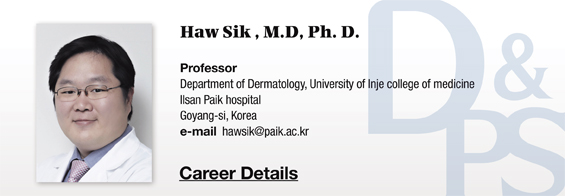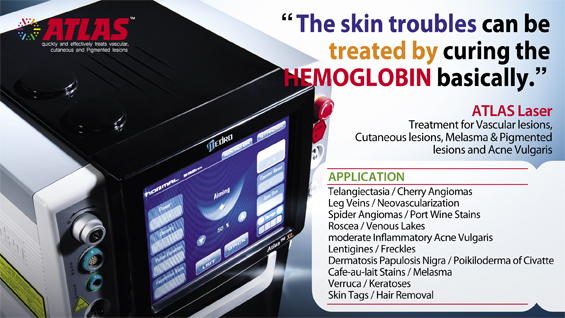▶ Previous Artlcle : #3-2. Diseases associated with clinical presentations
Various modalities exist for the treatment of vitiligo. In other words, vitiligo is a condition that requires combination of treatments as a single method is often ineffective. Treatment of vitiligo largely consists of medication, phototherapy and surgery.
[Advertisement] ATLAS(Long pulse 532nm & 940nm dual wavelength) – Manufacturer: MEDRO(www.medro.net)
1. Medication
Steroids
Steroids is the most widely known primary treatment of vitiligo. As a single treatment, it is the most effective, despite the risk of side effects. In combination with phototherapy, it brings excellent therapeutic effect. In progressive vitiligo lesions, inflammatory cells including macrophages and T-cells gather and destruction of melanocytes by autoantibodies and complements is observed. Steroids prevent destruction of melanocytes by the above mechanism and promotes melanocyte redistribution and melanogenesis in vitiligo lesions.
As shown in many studies, topical steroids are more effective in children than in adults and especially, the head and neck areas respond well to this type of treatment. Topical steroids are also effective in combination with ultraviolet A. According to Westerhof, combination of fluticasone, a topical corticosteroid, and UV A was three times more effective than fluticasone alone.
Oral steroids is often not considered as a primary treatment due to the high risk of side effects. However, when it comes to slowing the disease progression by inhibiting the immune response, oral steroids can be an excellent choice of treatment.
The efficacy of oral steroids is enhanced in combination with UV therapy. Rath compared the effect of the oral steroid pulse therapy alone, combination of oral steroid with short-wavelength UV B, long-wavelength UV B, and Psolaren UV A in progressive vitiligo. It was found that among the four treatment modalities, the group receiving a combination of an oral agent and short-wavelength UV B had the best outcome.
The biggest concern in using steroids is the occurence of local and systemic side effects. Local side effects include epidermal atrophy, angiectasis, striae distensae, and foliculitis, etc. Systemic side effects include insomnia, acne, menstrual irregularity, weight gain, hypertrichosis, and hypoadrenalism, etc. Topical steroids can also affect blood cortisol levels and this is more closely related to the area of application (head and neck) rather than the potency of steroid. According to a study, approximately 69% of patients receiving steroid pulse therapy experienced systemic side effects. Therefore, it is necessary to be extra cautious of side effects when using steroids.
Topical calcineurin inhibitors
Topical calcineurin inhibitors can effectively inhibit immune response without the risk of side effects associated with steroids. It has efficacy comparable to that of topical steroids. Calcineurin acts as a transcription factor of inflammatory cytokines such as IL-2 and TNF-a, etc. in lymphocytes and dendritic cells. It is a well-known fact that patients with vitiligo have increased levels of IL-10, TNF-a, and IFN-r, etc. compared to the healthy population. Topical calcineurin inhibitors reduce TNF-a in tissues and promote proliferation of melanocytes and melanoblasts. Many studies reported that application of topical tacrolimus and pimecrolimus on lesions for 3-6 months brought symptom improvement in 63-89% of the patients. They also found that application on the head and neck lesions brought the best outcome. As side effects are very mild, lesions in areas of low response such as limbs may experience more benefit from occlusive dressing after ointment application.
When used alone, the efficacy of topical calcineurin inhibitors is similar to or slightly lower than topical steroids. Combination with short-wavelength UV B, or 308nm Excimer laser is more effective than topical treatment alone. In combination with phototherapy, topical calcineurin inhibitor brings moderate response in vitiligo lesions not responding to other treatments.
Side effects are mild and include erythema, pruritus, irritation, hyperpigmentation, and acne. Concerns over the risk of skin cancer associated with the use of topical calcineurin inhibitors in immunocompromised patients have been raised, however, there is lack of confirmatory evidence for the association. A supplemental study involving 20,000 patients also showed no association between the topical agent and various types of skin cancer including lymphoma.
Vitamin D3 derivatives
Among vitamin D3 derivatives, calcipotriene is often used in treatment of vitiligo. Calcipotriene has an immunomodulating action and promotes development of melanocytes and melanin synthesis. when used alone, its efficacy pales behind steroids. In most cases, it is used as an adjunct to topical steroids.
Combination brings superior outcomes and accelerates repigmentation of the lesion. It can be effective in lesions not responding to previous topical steroid therapy. Controversy remains as to the effect of a vitamin D3 derivative in combination with phototherapy and further investigation is needed. Side effects are mild and include slight irritation.
Antioxidants
Although not widely used in Korea, antioxidants may be used to prevent destruction of melanocytes by reactive oxygen species. Antioxidants most often used in vitiligo include vitamins E & C, alphalipoic acid, ginkgo biloba, topical catalase, superoxide dismutase, and polypodium leucotomos, etc.
Methionine sulfoxide reductase which protects cells from reactive oxygen species is reduced in a vitiligo lesion and therefore melanocytes are damaged from oxidative stress. Ingestion of alphalipoic acid, vitamin C, vitamin E, and polyunsaturated fatty acids, etc. may activate catalase and reduce activity of reactive oxygen species.
Not may studies have so far shown the effect of antioxidants in vitiligo. Dell Anna et al. reported that simultaneous administration of antioxidants with short-wavelength UV B brought superior efficacy compared to phototherapy alone. Another study reported that topical use of catalase/superoxide dismutase was just as effective as topical 0.05% betamethasone. Antioxidants are relatively safe and affordable, however, further study is warranted to accurately establish dosage, efficacy as well as the risk of side effects.
2. Phototherapy
Treatment of vitiligo with UV started from around 1800s and is one of the longest-running treatment modalities. A precise mechanism of action has yet to be understood, however, it is considered to promote transfer and proliferation of melanocytes, create an environment conducive to melanocyte growth and inhibit autoimmunity.
Although UV A has been approved by FDA to be used in vitiligo, its efficacy is somewhat lacking when applied alone. A study reported that UV A in a high dose of 15J/㎠ brought 60% of repigmentation in half of the patients. Combination with psoralen increases the efficacy and over half of patients experienced 70-100% response in lesions in the head and neck.
UV B is recently the most widely used treatment of vitiligo and short-wavelength UV B of 311nm is particularly effective. Short-wavelength UV B induces tyrosinase activity and increases expression of HBM45 at the surface of melanosome. When used alone, the response rate is reported to vary from 41.6% to 100%. It is effective against lesions of children, and newly developing lesions, with the best response shown in the head and neck areas. It is just as or slightily more effective than PUVA. Compared to PUVA, UV B more effectively stabilizes the disease and induces pigmentation, however, the time to response tends to be longer.
Regular maintenance of the device is required to provide an appropriate light intensity. A regular check-up should be performed to ensure proper intensity of UV radiation. In order to prevent burns, adjustment of radiation dose is necessary. Burns from UV radiation is especially likely in a patient returning to treatment after several weeks of hiatus. The Journal of American Academy of Dermatology (JAAD) recommends a reduction of 25% in dose for every week that has been missed.
General side effects include erythema, pruritus, and headache, etc. A two-degree burn may result from incorrect adjustment of light intensity. Controversy exists over whether phototherapy can cause skin cancer, however, based on recent reports, long-term UV therapy is unlikely to increase the risk of skin cancer. Phototherapy and laser are effective and safe enough to be used in pregnant women. On the other hand, the treatment frequency of 2-3 times a week may be a barrier to good compliance in some patients.
-To be continued-
▶ Next Artlcle : #4-2. Treatment of Vitiligo





















